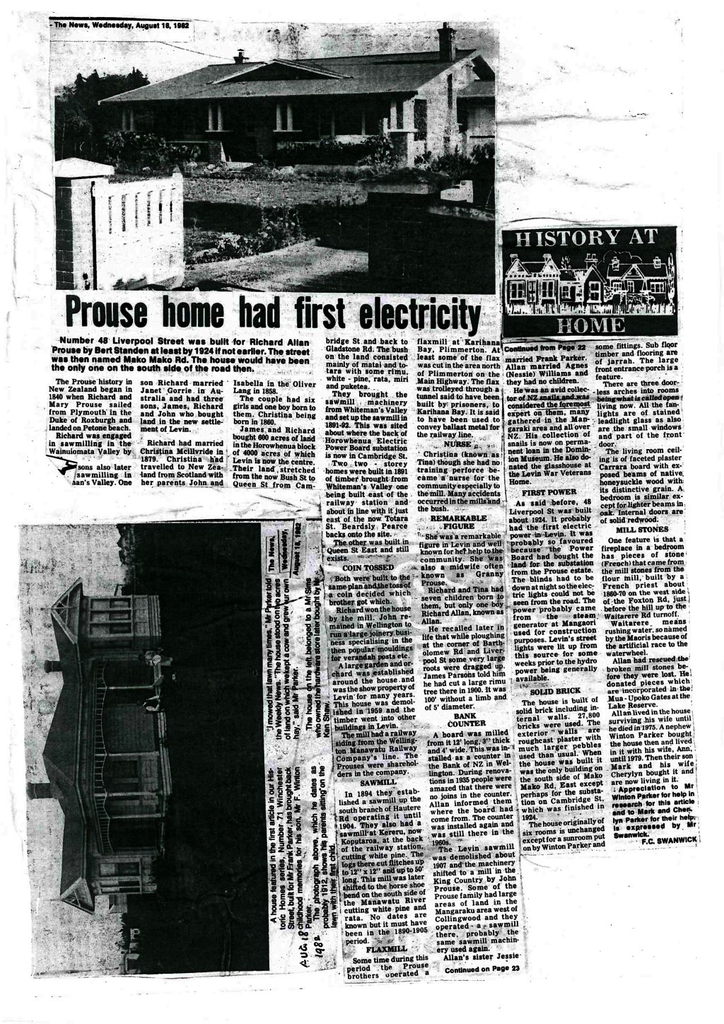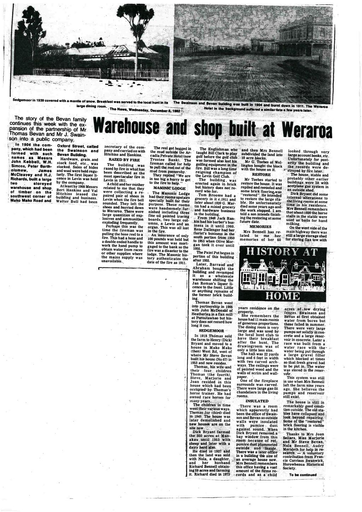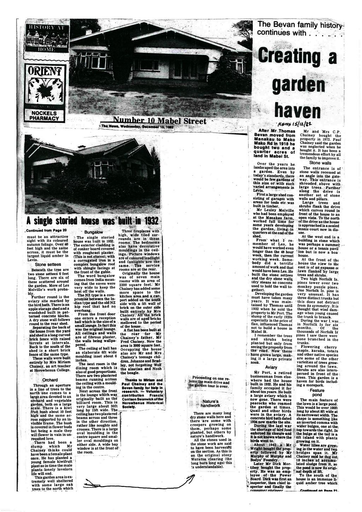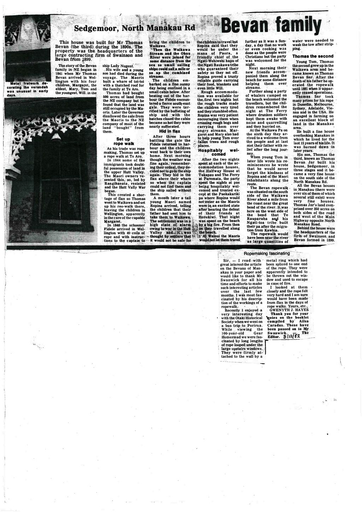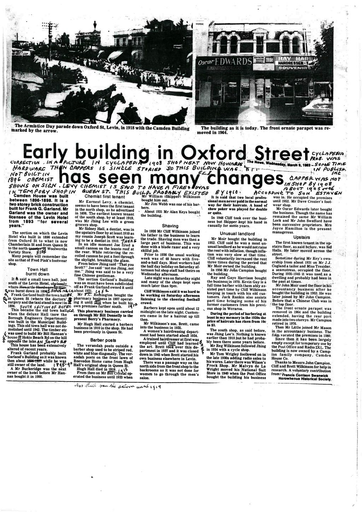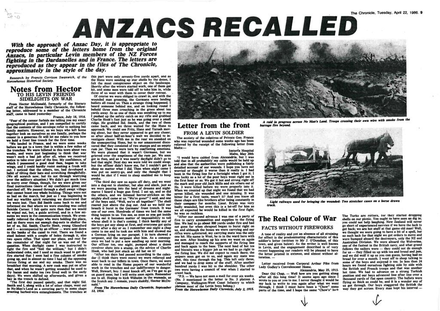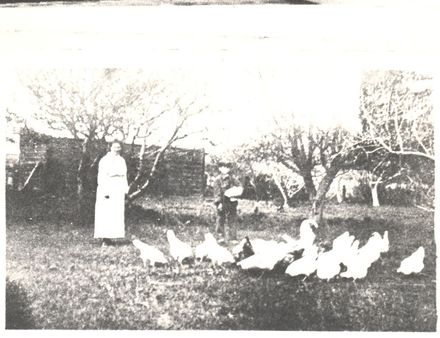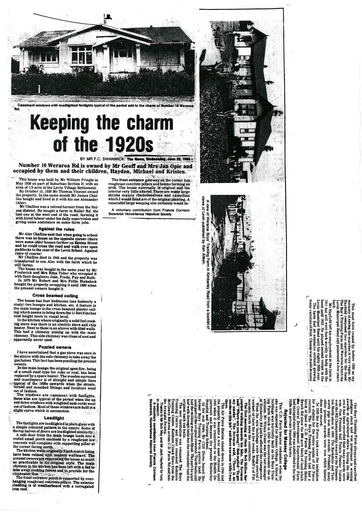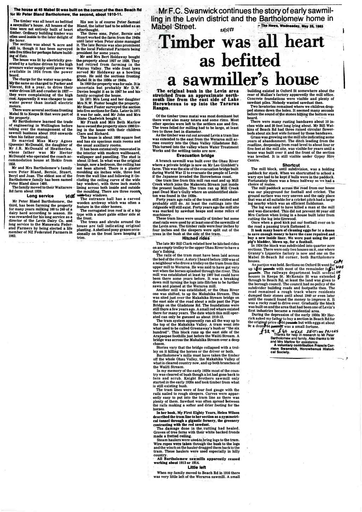Prouse Home had First Electricity
- Description
 The Prouse history in New Zealand began in 1840 when Richard and Mary Prouse sailed from Plymouth in the Duke of Roxburgh and landed on Petone beach.
The Prouse history in New Zealand began in 1840 when Richard and Mary Prouse sailed from Plymouth in the Duke of Roxburgh and landed on Petone beach. Richard was engaged in sawmilling in the Wainuiomata Valley by ... [unclear copy] …sawmilling in Whiteman’s Valley. One son Richard married Janet Gorrie in Australia and had three sons, James, Richard and John who bought land in the new settlement of Levin.
Richard had married Christina Mcillvride in 1879. Christina had travelled to New Zealand from Scotland with her parents John and Isabella in the Oliver Lang in 1858.
The couple had six girls and one boy born to them. Christina being born in 1860.
James and Richard bought 600 acres of land in the Horowhenua block of 4000 acres of which Levin is now the centre. Their land stretched from the now Bush St to Queen St from Cambridge St and back to Gladstone Rd. The bush on the land consisted mainly of matai and totara with some rimu, white-pine, rata, miri and puketa.
They brought the sawmill machinery from Whiteman’s Valley and set up the sawmill in 1891-92. This was sited about where the back of Horowhenua Electric Power substation is now in Cambridge St.
The two-storey homes were built in 1891 of timber brought form Whiteman’s Valley; one being built east of the railway station and about in line with it, just east of the now Totara St. Beardsley Pearce backs onto the site.
The other was built in Queen St East and still exists.
Coin tossed
Both were built to the same plan and the toss of a coin decided which brother got which.
Richard won the house by the mill. John remained in Wellington to run a large joinery business specialising in the then popular mouldings for verandah posts, etc.
A large garden and orchard was established around the house and was the show property of Levin for many years. This house was demolished in 1959 and the timber went into other buildings in Levin.
The mill had a railway siding from the Wellington Manawatu Railway Company’s line. The Prouses were shareholders in the company.
Sawmill
In 1894 they established a sawmill up the south branch of Hautere Rd operating it until 1904. They also had a sawmill at Kereru, now Koputaroa, at the back of the railway station cutting white pine. The logs there were cut into flitches up to 12”x12” and up to 50’ long. This mill was later shifted to the horse-shoe bend on the south side of the Manawatu River cutting white pine and rata. No dates are known but it must have been in the 1890-1905 period.
Flaxmill
Some time during this period the Prouse bothers operated a flaxmill at Karihana Bay, Plimmerton. At least some of the flax was cut in the area north of Plimmerton on the Main Highway. The flax was trolleyed through a tunnel said to have been built by prisoners, to Karihana Bay. It is said to have been used to convey ballast metal for the railway line.
Nurse
Christina (known as Tina) though she had no training, perforce became a nurse for the community especially to the mill. Many accidents occurred in the mills and the bush.
Remarkable figure
She was a remarkable figure in Levin and well known for her help to the community. She was also a midwife often known as Granny Prouse.
Richard and Tina had seven children born to them, but only one boy Richard Allan, known as Allan.
He recalled later in life that while ploughing at the corner of Bartholomew Rd and Liverpool St some very large roots were dragged up. James Parsons told him he had cut a large rimu tree there in 1900. It was 100’ without a limb and of 5’ diameter.
Bank counter
A board was milled from it 12’ long, 3’ thick and 4’ wide. This was installed as a counter in the Bank of NZ in Wellington. During renovations in 1935 people were amazed that there were no joins in the counter. Allan informed them where the board had come from. The counter was installed again and was still there in the 1960s.
The Levin sawmill was demolished about 1907 and the machinery shifted to a mill in the King Country by John Prouse. Some of the Prouse family had large areas of land in the Mangaraku area west of Collingwood and they operated a sawmill there, probably the same sawmill machinery used again.
Allan’s sister Jessie married Frank Parker. Allan married Agnes (Nessie) Williams and they had no children.
He was an avid collector of NZ snails and was considered the foremost expert on them, many gathered in the Mangaraki area and all over NZ. His collection of snails is now on permanent loan in the Dominion Museum. He also donated the glasshouse at the Levin War Veterans Home.
First Power
As said before, 48 Liverpool St was built about 1924. It probably had the first electric power in Levin. It was probably so favoured because the Power Board had bought the land for the substation from the Prouse estate. The blinds had to be down at night so the electric lights could not be seen from the road. The power probably came from the steam generator at Mangaori used for construction purposes. Levin’s street lights were lit up from this source for some weeks prior to the hydropower being generally available.
Solid Brick
The house is built of solid brick including internal walls. 27,800 bricks were used. The exterior walls are roughcast plaster with much larger pebbles used than usual. When the house was built, it was the only building on the south side of Mako Mako Rd East except perhaps for the substation on Cambridge St, which was finished in 1924.
[ Corrie corrected this: "There were several mill cottages down from Cambridge St. corner earlier." ]
The house, originally of six rooms, is unchanged except for a sunroom put on by Winton Parker and some fittings. Sub floor timber and flooring are of jarrah. The large front entrance porch is a feature.
There are three door less arches into rooms being what is called open living now. All the fan lights are of stained leadlight glass as also are the small windows and part of the front door.
The living room ceiling is of faceted plaster Carrara board with exposed beams of native honeysuckle wood with its distinctive grain. A bedroom is similar except for lighter beams in oak. Internal doors are of solid redwood.
Mill Stones
One feature is that a fireplace in a bedroom has pieces of stone (French) that came from the mill stones from the flour mill, built by a French priest about 1860-70 on the west side of the Foxton Rd, just before the hill up to the Waitarere Rd turnoff.
Waitarere means rushing water, so named by the Maoris because of the artificial race to the waterwheel.
Allan had rescued the broken mill stones before they were lost. He donated pieces which are incorporated in the Mau-Upoko Gates at the Lake Reserve.
Allan lived in the house surviving his wife until he died in 1975. A nephew Winton Parker bought the house then and lived in it with his wife, Ann, until 1979. Then their son Mark and his wife Cherylyn bought it and are now living in it.
Appreciation to Mr Winton Parker for help in research for this article and to Mark and Cherylyn Parker for their help is expressed by Mr Swanwick.
Identification
- Date
- August 18, 1982
Taxonomy
- Community Tags


